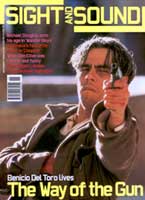
Mr Memory
Film of the Month: Memento

A new spin on noir, Memento is a memorable tale of forgetful sleuth.
Editor's note: the following review necessarily reveals key surprises in Memento's plot
Christopher Nolan's low-budget black-and-white debut Following (1998) was a film to get excited about. A British thriller set in a bleary but recognisable London with not a mockney gangster in sight, it was the work of a film-maker clearly capable of breathing new life into stock noir devices. In his LA-shot follow-up Memento Nolan continues to invigorate the genre: a remarkable psychological-puzzle film, a crime conundrum that explores the narrative possibilities of noir, Memento turns its detective hero Leonard Shelby into a surrogate for the spectator, its backward narrative logic forcing us to embark on the kind of investigative work Shelby is engaged in.
Shelby - played utterly convincingly by Guy Pearce as a combination of dogged determination and gaping bewilderment - is a former insurance investigator who since his wife's rape and apparent murder suffers from a condition that makes him unable to form new memories. But despite his severely limited powers of recollection he has vowed to find his wife's killer, whose initials he knows are "JG".
While there's a tradition of amnesia narratives in noir - from George Marshall's 1945 The Blue Dahlia to Scott McGehee's 1993 neo-noir Suture - Nolan's audacious approach sets Memento apart. The opening sequence hints of what's to come: a hand holds up a Polaroid photograph of a murder scene which slowly un-develops, fading to darkness. Nolan follows this with a murder that plays in rewind - the victim's blood seeps up a wall back into his head wound, bullet cartridges spin back into the gun's chamber - erasing the act of killing. From then on, though the film reverts to forward motion, events leading up to this murder are told in sequences that appear in reverse order. We get snatches of scenes which initially make no sense. Only when the film loops out from small details to the larger context does the story begin to form into a cohesive whole.
Nolan pulls off this complicated narrative structure with great flair. Unlike Martin Amis' 1991 novel Time's Arrow - which used a similar device to tell the story of a Nazi's life from death to birth - the effect is compelling rather than gimmicky. At heart Memento is a detective story, as Leonard makes clear to undercover cop Teddy, who claims to be helping him to track down his wife's killer. "Facts," he says, "not memories. That's how you investigate." Keeping track of his search with scribbled notes, clues tattooed on his body and sheaves of documents, Leonard anchors his investigation in what he believes are concrete givens. But each time the film reveals the context for his suppositions Leonard is shown to be mistaken.
It's a familiar noir trick - pulling the rug out from under the audience. But here Nolan gives the genre's tendency to confound our expectations a conceptual twist by linking the flow of narrative information to Leonard's condition. One of the ways Leonard attempts to navigate the set of unconnected instants that constitute his experience of time is by taking Polaroids. Each image has scribbled addenda: Teddy's reads "Do not believe his lies"; the picture of Natalie, the waitress Leonard hooks up with, has "She's lost someone too. She'll help you out of pity." For Leonard - and for us, too - these memory cue-cards are clues in the murder hunt; but there's a wealth of blink-and-you'll-miss-it evidence scattered throughout the film's spiralling narrative structure to suggest that Leonard's "facts" don't necessarily tell the whole story. On Natalie's Polaroid, for instance, a line has been scribbled out, a detail that instils doubts about her long before it becomes clear she's mercilessly exploiting Leonard's condition for her own ends. In the best noir tradition, it's hard to trust any of the characters here - from Teddy, played with wheedling shiftiness by Joe Pantoliano, down to the clerk in the motel where Leonard is staying who admits he's ripping him off by booking him into a less luxurious room in the knowledge Leonard will promptly forget the guilty confession.
Leonard's reliance on his remembered past - he claims to recall his life before the murder of his wife - is one of the anchoring elements of the film. Running parallel with the fractured eternal present tense of the protagonist's everyday life is the story of a case he investigated when working for an insurance firm: that of Sammy Jankis, who was afflicted with similar short-term memory loss. In an extended black-and-white flashback Leonard relates over the phone - to a cop we can only assume is Teddy - how he was suspicious of Jankis who despite his condition could nonetheless administer the correct insulin doses to his diabetic wife. The claim refused, Sammy's wife attempted to snap her husband out of his amnesia by making him repeatedly inject her with insulin shots. But the ploy backfired tragically, leaving her dead and Sammy still adrift in memory-less limbo. Caught, like Leonard, in the film's looping reverse narration, we can't help but cling to this flashback as having some kind of authority. It serves as a case history of Leonard's condition and illuminates his attempts to snap out of it - he hires a hooker to help him restage his memories of his last night with his wife, only to nod off and forget about it - as well as adding an emotionally compelling counter-narrative to the chilly formal virtuosity on display. But even this seemingly reliable flashback is undermined: at gunpoint, Teddy tells Leonard he has completely revised his memory of the Sammy Jankis case to avoid facing the fact that his own wife, who survived the assault, died after he over-administered insulin to her. Jankis was a conman whom Leonard, in a state of extreme denial, has reconstructed as a pitiful victim.
While such final-reel revelations - which actually occur at the beginning of the film's story - provide a satisfying explanation of the kaleidoscope of conflicting details, the real pleasure of Memento lies in its openness to re-viewing and hence to interpretation. Drawing from the rich metafictional possibilities inherent in the detective genre, Memento delivers, in Leonard Shelby, a character who, while he considers himself an investigator, is actually - and all at once - a proficient killer and the perfect patsy: fuelled by his lust for revenge, he'll take out anybody with the initials that fit; dependent on others to provide clues to the identity of his wife's killer, he's also the victim of countless set-ups, the seemingly unwitting cog in the duplicitous manoeuvrings of those around him. At times he's like a wind-up genre automaton who grinds to a halt until the next bout of clues prompts him into action.
Nolan doesn't shy away from the darkly farcical potential of Leonard's condition, having him blunder into scrapes and shoot-outs through misreading his scribbled notes or simply forgetting what was going on a few minutes earlier. But while his amnesia might be exploited by others for greed or revenge, the film's greatest trick is to end by questioning his innocence: "Do I lie to myself to be happy?" he asks after Teddy has given him his version of his wife's death. "In your case Teddy, I will," he tells himself as he writes down the cop's car-registration number, falsely incriminating him as his wife's killer and effectively signing his death warrant. It's a mark of Nolan's achievement that this final scene - which seemingly completes the narrative jigsaw - should cast a cloud over Leonard's motives. It's a stunning tease, a tantalisingly ambiguous note on which to sign off, one that scatters our sense of certainty as we rerun the events of the past two hours in our heads.
